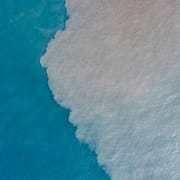
USS Kittiwake, From Submarine Rescue to Submerged
The USS Kittiwake (ASR-13) launched July 10, 1945 in Savannah Georgia. After commissioning in July of 1946, she served as a submarine rescue ship. Submarine sea trials and maneuvers brought the Kittiwake up and down the east coast of the USA and all over the Caribbean. Submariners rested easier knowing divers on the Kittiwake above would rescue them should any trouble ensue.
The name Kittiwake comes from gulls living along the cost of North America that look much like common seagulls. First based in Balboa, the Kittiwake spent many years in the Caribbean.
Divers from the Kittiwake recovered practice torpedoes during sea trials. The ship sometimes made runs as a practice target for the submarines she served. When the battleship Missouri ran aground in tidal banks off the coast of Virginia in 1950, divers from the Kittiwake came with salvage equipment to set her free.
In 1960, the Kittiwake stood at hand while the submarine George Washington successfully launched the first two Polaris ballistic missiles ever launched from beneath the sea.
In 1961 the Kittiwake sailed to the Mediterranean for several months of service before returning to her home port in Virginia. Over the course of her service she made more trips across the Atlantic to the Mediterranean and Europe.
Cuban refugees off the coast of Key West, Florida thanked the Kittiwake for carrying them safely to shore while off-duty in 1963.
The Kittiwake did many interesting things during her years of service. At one point she towed a submarine from the US to Scotland. The official reason given was for a group of scientists to study tilefish. Undercover undersea, that mission covered the changing of boxes used to monitor Soviet submarine activity whose location had been compromised by a spy. During the mission a Russian spy ship attempting a disguise as a fishing vessel appeared. Soon an attack sub surfaced backed by a fast American frigate. The Russian spy ship quickly vacated the area.
While back in the Mediterranean in 1966, the Kittiwake assisted with locating and salvaging the German submarine Hai (S-171) which sank in a gale.
The unsuccessful search for the USS Scorpion in 1968 brought the Kittiwake to the Atlantic Ocean. The Scorpion was the second US nuclear submarine lost at sea. Though the wreck has since been found, controversy remains as to whether it sank due to attack from a Soviet submarine or from internal problems.
April of 1984 found the Kittiwake at the dock in Norfolk, Virginia for maintenance and repair. Upon trying to leave the pier, the Kittiwake attempted to go forward and ended up in reverse. The harder she tried to go forward, the faster she went in reverse. Motion ceased upon colliding with the attack submarine USS Bergall, moored behind her. Turned out the main motor drive had been wired improperly, causing the screw to turn backward.
In 1986 the Kittiwake salvaged an F-15 down in about 300 feet of water and recovered the black box from the Challenger space shuttle disaster.
In 1994 the Kittiwake was decommissioned. She sat in the graveyard of decommissioned ships for a time until the Cayman Islands took an interest. After years of negotiations, the Cayman Islands managed to buy the Kittiwake, the first former US military ship sold to another nation. A planned 2009 sinking went awry due to environmental concerns regarding the possibility of banned chemicals in the sealant in some gaskets. It took until January 2011 before the ship was finally towed out for sinking off 7-mile beach and a new life as an artificial reef. The Kittiwake sank upright and came to rest on a sandy ocean floor. After spending so much time following submarines around the Caribbean it only seems fitting that the Kittiwake found its final resting place submerged there.
The ship did not have long to settle before Hurricane Rina passed within 100 miles of the Cayman islands. Strong waves from the winds of the hurricane pushed the Kittiwake about 60 feet further from the shore than the original location of her sinking. One anchor chain broke, and the ship now sits on the three starboard anchors, listing slightly to one side under 10 feet deeper water than in the original position.
The ship pushed enough sand in the underwater slide to create a sand bank now holding the hull more firmly in place. The ship still lies in shallow enough water for a clear view from snorkelers overhead and easy access for divers. It is far enough under now that snorkelers can no longer stand on deck with their heads out of water as they did in the original location.
Fish moved in shortly after the original sinking, finding good places to hide and call home within the ship’s structure. Algae covers the once-white ship, As the years pass more sea life will cling to the hull until in time it becomes a new reef, changing the view from sunken ship to a multitude of sea life.
A variety of operators in Grand Cayman take divers and snorkelers out to the Kittiwake. They know the rules regarding mandatory fees and time limits, so guests on organized tours need not worry. Cruise lines such as Carnival also offer snorkel trips to the Kittiwake among their shore excursions for Grand Cayman.
Source by Lois Beath



